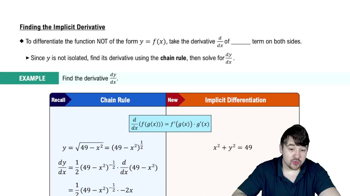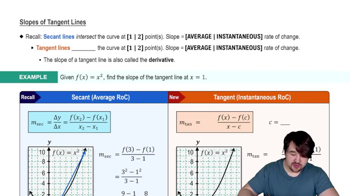Table of contents
- 0. Functions7h 52m
- Introduction to Functions16m
- Piecewise Functions10m
- Properties of Functions9m
- Common Functions1h 8m
- Transformations5m
- Combining Functions27m
- Exponent rules32m
- Exponential Functions28m
- Logarithmic Functions24m
- Properties of Logarithms34m
- Exponential & Logarithmic Equations35m
- Introduction to Trigonometric Functions38m
- Graphs of Trigonometric Functions44m
- Trigonometric Identities47m
- Inverse Trigonometric Functions48m
- 1. Limits and Continuity2h 2m
- 2. Intro to Derivatives1h 33m
- 3. Techniques of Differentiation3h 18m
- 4. Applications of Derivatives2h 38m
- 5. Graphical Applications of Derivatives6h 2m
- 6. Derivatives of Inverse, Exponential, & Logarithmic Functions2h 37m
- 7. Antiderivatives & Indefinite Integrals1h 26m
- 8. Definite Integrals4h 44m
- 9. Graphical Applications of Integrals2h 27m
- 10. Physics Applications of Integrals 2h 22m
4. Applications of Derivatives
Implicit Differentiation
Problem 3.87
Textbook Question
In Exercises 83–88, find equations for the lines that are tangent, and the lines that are normal, to the curve at the given point.
__
x + √xy = 6, (4, 1)
 Verified step by step guidance
Verified step by step guidance1
First, understand that the problem requires finding the tangent and normal lines to the curve given by the equation \(x + \sqrt{xy} = 6\) at the point (4, 1). The tangent line is the line that just touches the curve at this point, while the normal line is perpendicular to the tangent line at this point.
To find the equation of the tangent line, we need to determine the derivative of the curve with respect to x, which will give us the slope of the tangent line at the point (4, 1). Start by differentiating both sides of the equation \(x + \sqrt{xy} = 6\) with respect to x. Use implicit differentiation since y is a function of x.
Differentiate the left side: The derivative of \(x\) is 1. For \(\sqrt{xy}\), use the chain rule: \(\frac{d}{dx}(\sqrt{xy}) = \frac{1}{2\sqrt{xy}} \cdot (y + x \frac{dy}{dx})\). Set the derivative of the right side, which is a constant, to 0.
Solve the resulting equation for \(\frac{dy}{dx}\) to find the slope of the tangent line at the point (4, 1). Substitute x = 4 and y = 1 into the derivative to find the specific slope at this point.
Once you have the slope of the tangent line, use the point-slope form of a line equation, \(y - y_1 = m(x - x_1)\), where m is the slope and (x_1, y_1) is the point (4, 1), to write the equation of the tangent line. For the normal line, use the negative reciprocal of the tangent slope as the slope of the normal line, and apply the point-slope form again to find its equation.
 Verified video answer for a similar problem:
Verified video answer for a similar problem:This video solution was recommended by our tutors as helpful for the problem above
Video duration:
5mPlay a video:
Was this helpful?
Key Concepts
Here are the essential concepts you must grasp in order to answer the question correctly.
Implicit Differentiation
Implicit differentiation is a technique used to differentiate equations where the dependent and independent variables are not explicitly separated. In this case, we differentiate both sides of the equation with respect to x, treating y as a function of x. This allows us to find dy/dx, which is essential for determining the slope of the tangent line at a specific point.
Recommended video:

Finding The Implicit Derivative
Tangent Line
A tangent line to a curve at a given point is a straight line that touches the curve at that point without crossing it. The slope of the tangent line is equal to the derivative of the function at that point. To find the equation of the tangent line, we use the point-slope form of a line, which requires the slope and the coordinates of the point of tangency.
Recommended video:

Slopes of Tangent Lines
Normal Line
The normal line to a curve at a given point is perpendicular to the tangent line at that point. Its slope is the negative reciprocal of the slope of the tangent line. To find the equation of the normal line, we again use the point-slope form, substituting the coordinates of the point and the calculated slope of the normal line.
Recommended video:

Slopes of Tangent Lines

 5:14m
5:14mWatch next
Master Finding The Implicit Derivative with a bite sized video explanation from Nick
Start learningRelated Videos
Related Practice


